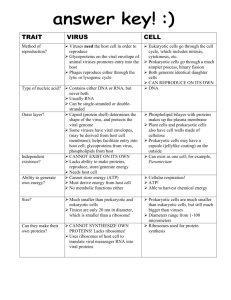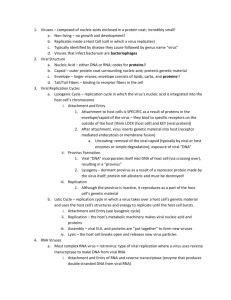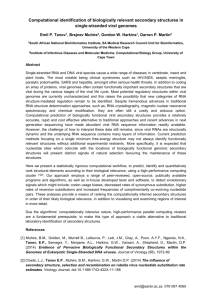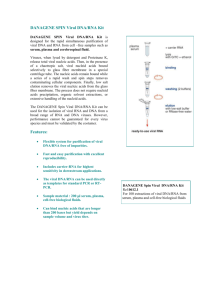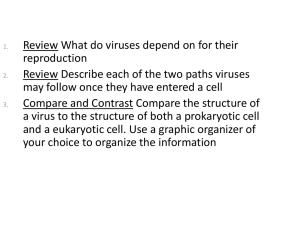Notes about viruses
advertisement
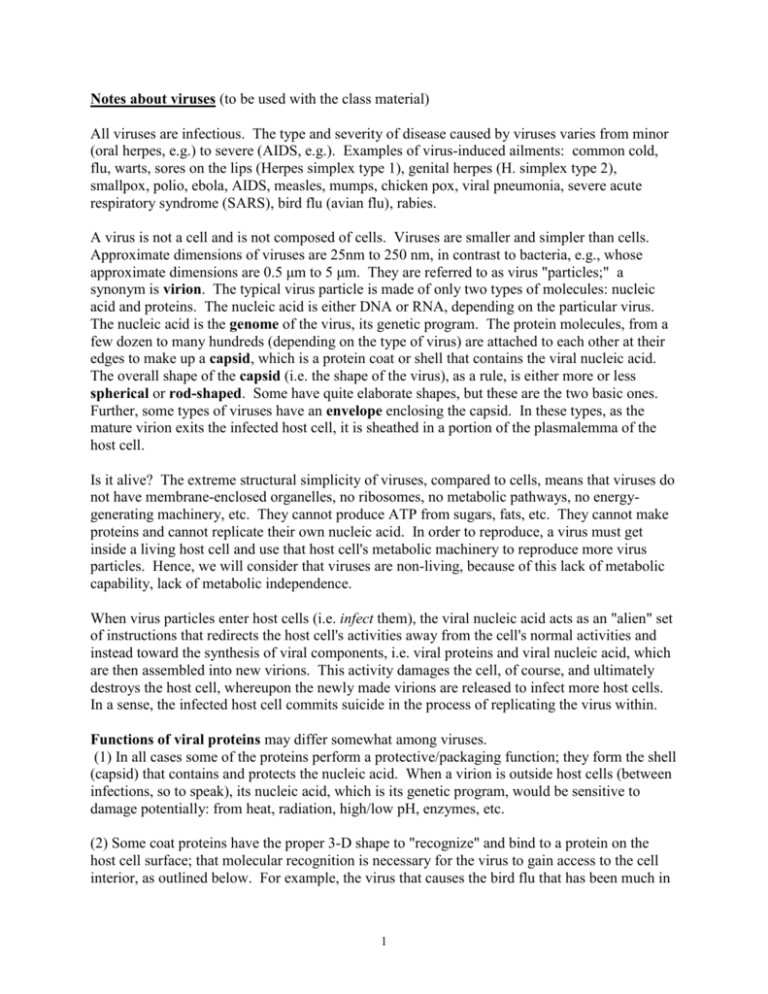
Notes about viruses (to be used with the class material) All viruses are infectious. The type and severity of disease caused by viruses varies from minor (oral herpes, e.g.) to severe (AIDS, e.g.). Examples of virus-induced ailments: common cold, flu, warts, sores on the lips (Herpes simplex type 1), genital herpes (H. simplex type 2), smallpox, polio, ebola, AIDS, measles, mumps, chicken pox, viral pneumonia, severe acute respiratory syndrome (SARS), bird flu (avian flu), rabies. A virus is not a cell and is not composed of cells. Viruses are smaller and simpler than cells. Approximate dimensions of viruses are 25nm to 250 nm, in contrast to bacteria, e.g., whose approximate dimensions are 0.5 μm to 5 μm. They are referred to as virus "particles;" a synonym is virion. The typical virus particle is made of only two types of molecules: nucleic acid and proteins. The nucleic acid is either DNA or RNA, depending on the particular virus. The nucleic acid is the genome of the virus, its genetic program. The protein molecules, from a few dozen to many hundreds (depending on the type of virus) are attached to each other at their edges to make up a capsid, which is a protein coat or shell that contains the viral nucleic acid. The overall shape of the capsid (i.e. the shape of the virus), as a rule, is either more or less spherical or rod-shaped. Some have quite elaborate shapes, but these are the two basic ones. Further, some types of viruses have an envelope enclosing the capsid. In these types, as the mature virion exits the infected host cell, it is sheathed in a portion of the plasmalemma of the host cell. Is it alive? The extreme structural simplicity of viruses, compared to cells, means that viruses do not have membrane-enclosed organelles, no ribosomes, no metabolic pathways, no energygenerating machinery, etc. They cannot produce ATP from sugars, fats, etc. They cannot make proteins and cannot replicate their own nucleic acid. In order to reproduce, a virus must get inside a living host cell and use that host cell's metabolic machinery to reproduce more virus particles. Hence, we will consider that viruses are non-living, because of this lack of metabolic capability, lack of metabolic independence. When virus particles enter host cells (i.e. infect them), the viral nucleic acid acts as an "alien" set of instructions that redirects the host cell's activities away from the cell's normal activities and instead toward the synthesis of viral components, i.e. viral proteins and viral nucleic acid, which are then assembled into new virions. This activity damages the cell, of course, and ultimately destroys the host cell, whereupon the newly made virions are released to infect more host cells. In a sense, the infected host cell commits suicide in the process of replicating the virus within. Functions of viral proteins may differ somewhat among viruses. (1) In all cases some of the proteins perform a protective/packaging function; they form the shell (capsid) that contains and protects the nucleic acid. When a virion is outside host cells (between infections, so to speak), its nucleic acid, which is its genetic program, would be sensitive to damage potentially: from heat, radiation, high/low pH, enzymes, etc. (2) Some coat proteins have the proper 3-D shape to "recognize" and bind to a protein on the host cell surface; that molecular recognition is necessary for the virus to gain access to the cell interior, as outlined below. For example, the virus that causes the bird flu that has been much in 1 the news in recent years is the H5N1 strain. H5 and NI refer to two proteins on the virion surface. H5 refers to "hemagglutinin," a virus surface protein that is necessary for the virus to bind to the host cell and gain entry. The N1 protein (neuraminidase) is necessary for the virus to leave the cell. (3) Some viral proteins are enzymes. For instance, HIV, the AIDS virus, contains the reverse transcriptase enzyme needed for viral nucleic acid replication. The host cell lacks this enzyme. Also, some viruses contain enzymes that damage the host cell membrane, allowing viral escape from the host cell. Another, called integrase, is necessary for the viral DNA to be inserted into a host cell DNA molecule to initiate the latent phase of the infection cycle. Function of the viral nucleic acid. A. The DNA of a virus is a set of genes, just as is true of the DNA within chromosomes of cells. But viral genes have the effect of "hijacking" the host cells activities and directing the use of host resources toward making new viral components. These host resources include energy, amino acids (to make proteins), nucleotides (to make nucleic acid molecules), ribosomes, tRNAs. Viral DNA directs the host's enzymes to make more viral DNA. Viral DNA also directs the host's enzymes to make viral RNA (that's transcription, of course), which functions as mRNA in the production of viral proteins. The DNA in viruses may be single stranded or double stranded, depending upon the type of virus. B. For RNA viruses, the entry of their RNA into the cell interior can be viewed as acting like a messenger RNA molecule. Note that the RNA in viruses may be single stranded or double stranded, depending upon the type of virus. The viral RNA is still considered the genome of the virus, since the RNA represents coded genetic information. That viral RNA, then, can direct the synthesis of viral proteins. However, making new virions requires that more viral RNA molecules be made. So, the replication of viral RNA requires something new, since in the past we've seen that host cells always make mRNA by using a DNA template. There are two solutions to this problem of how to make RNA by using an RNA template. 1. In some viruses there is an enzyme called RNA-dependent RNA polymerase (RDRP). It acts like the RNA polymerase we studied earlier, but it uses viral RNA as a template. The RNA polymerase of the host cell can't do that; it must have DNA as its template. So viral RDRP uses original viral RNA (call it +RNA) to make complementary RNA (call it –RNA) and then RDRP uses the newly made complementary RNA to make copies of the original viral RNA, which is what must be packaged into the new virions. Remember that both DNA polymerase and RNA polymerase make complementary strands. So, making new viral RNA requires first making complementary RNA strands (shown as "-RNA" in the drawing below). Then the -RNA strands are used as template to make new +RNA strands. Given this new RNA polymerase we should now refer to the RNA polymerase of the host cell as "DNA-dependent RNA polymerase," since it's not the same as the viral enzyme. 2 (original) +RNA) (-RNA) (new +RNA) 2. In retroviruses, such as Human Immunodeficiency Virus (HIV, the cause of AIDS), the virus contains a different enzyme that makes viral RNA. Here the viral RNA is double stranded RNA (dsRNA); the enzyme, called reverse transcriptase, uses the viral RNA to make viral DNA (again, it's a complementary molecule that's made) and then uses the viral DNA to make new viral dsRNA, which is packaged into the new virions. Host cells do not have this reverse transcriptase. Viral infection cycle. In general the following sequence of events is found in the infection cycle. 1. Binding and recognition. As a rule viruses are specific for their hosts. That is, a given virus infects a particular cell type in a particular species. The basis of this specificity is determined by the interaction of host cell surface proteins and viral surface proteins. In order for a virus to infect a cell, one of the viral capsid proteins must have the proper shape to "recognize" a protein on the surface of the host cell. Here is that key-into-lock principle of molecular recognition that we've seen before, in enzyme action and in membrane carrier protein action. Case 1: Viral surface protein and host surface protein "recognize" each other because of their complementary shapes and bind to each other. Hence, the cell is susceptible to this virus and the next step of the infection cycle can occur. Case 2: Viral surface protein and host surface protein do not recognize each other (shapes don't match). Hence, the cell is not susceptible to this virus, i.e. will not be a host, and there will be no infection. 2. Entry. Depending on the host-virus combination, the virion (or only its nucleic acid) enters the cell. For example, animal viruses will typically enter by endocytosis. The virus "tricks" the host cell into taking the virion inside via phagocytosis: a molecular version of the Trojan Horse saga. 3. Uncoating. Once inside the host cell, the virion comes apart. The capsid proteins detach from each other (perhaps due to the cytosolic pH), thereby releasing the viral nucleic acid inside the host cell: "the soldiers in the belly of the horse." 3 4. Replication. The viral nucleic acid redirects the host cell's metabolic activities toward manufacturing new viral components (nucleic acid and proteins). This is done at the expense of, with damage to, the host cell. 5. Assembly. The newly made viral nucleic acid and protein molecules are assembled into new virions. 6. Exit. The new virions escape from the host. Usually this happens when the damaged host cell dies and breaks open. In some cases, the host cell may remain alive for some time and release new virions via exocytosis over a long time period. Transduction. In some viruses the viral DNA may attach to the host cell DNA for a time. The effect of this is to pause the progress of the infection cycle, perhaps indefinitely. This period is called the latent stage; it occurs between uncoating and replication. Then when the viral DNA detaches later, a bit of host DNA may detach along with the viral DNA. The result is that this bit of host DNA may now be carried by newly made virions to the next infected host cell. Thus, a virus may act as a vector to move bits of host DNA (genes, that is) from one cell to another. If a gene for antibiotic resistance in one bacterial cell were so moved into another bacterial cell, then the recipient cell would become resistant to the same antibiotic. 4

